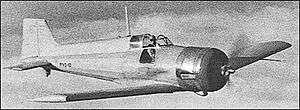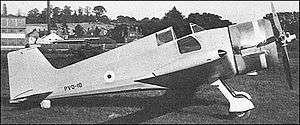Vickers Venom
| Venom | |
|---|---|
 | |
| Vickers Venom on a test flight in 1936 | |
| Role | Fighter |
| National origin | United Kingdom |
| Manufacturer | Vickers-Armstrongs Ltd |
| First flight | 17 June 1936 |
| Number built | 1 |
| Developed from | Vickers Jockey |
The Vickers Type 279 Venom was a low-wing monoplane single-seat, single-engined, eight-gun fighter, powered by a radial engine. It was fast and manoeuvrable but its engine lacked the power and development potential of its Merlin-powered competitors. Only one was built.
Design and development
The Vickers Venom[1] was designed to meet Air Ministry specification F.5/34 which called for a single-seat eight-gun aircraft with the high maximum speed and rate of climb needed to catch 200 miles per hour (320 km/h) bombers flying at 15,000 feet (4,600 m). The aircraft would have to use a radial engine as it was intended to be used overseas in hot climates. Vickers based their entrant on the earlier Type 151 Jockey fighter, using the same wing and tail airfoil sections and dimensions but replacing the Wibault-Vickers corrugated construction of the Jockey with a modern stressed skin structure.[2]

The Venom (originally known as the Jockey Mk II) was a low-wing monoplane, with square-tipped constant chord wings and tailplane. The fin, too, was square-tipped but the rather angular appearance did not extend to the fuselage, which tapered rearwards from the engine's long chord cowling back to the tail. The pilot sat over the wing in a perspex-enclosed cockpit, which had unusual additional windows in the fuselage for an enhanced side and downwards view. The inverted U-shaped fairing behind the cockpit extended back to the base of the fin.
The fuselage was an alloy-skinned monocoque structure of polygonal section, and the thicker plates of the wings were also stressed, taking the drag loads. The wings carried 90° flaps and there was a wide track, inward-retracting main undercarriage plus a small fixed tailwheel. Both the flaps and undercarriage were electrically operated. The deep RAF 34 wing section eased the installation of the required eight Browning machine guns. The Venom was powered by a 625 horsepower (466 kW) Bristol Aquila AE-3S sleeve valve radial engine, hinge-mounted so it could be swung sideways for easy maintenance. The Aquila drove a three-bladed propeller. Joseph "Mutt" Summers flew the Venom on her first flight, 17 June 1936. Unlike the Hurricane and Spitfire, the Venom was fitted with full armament from its first flight.[3]
Testing and evaluation
Publicly unveiled at the 1936 Society of British Aircraft Constructors (SBAC) display, the Venom appeared in natural polished metal and silver dope on the fabric control surfaces, with private venture registration markings: PVO-10.[4] In testing, the Venom performed well on the limited power of the Aquila, achieving a maximum speed of 312 miles per hour (502 km/h) and possessing an excellent climb rate. The compact radial engine gave the Venom a better rate of roll and turn than its long nosed water-cooled competitors but it was soon clear the potential power from the Merlin was greater than was likely to be available from the Aquila in the near future, with only limited development of this engine being undertaken, while no other engines were available suitable for fitting in such a small airframe.[5] Jeffrey Quill flew the Venom from Eastleigh, mixing it with Spitfires but the Venom's flying was limited by engine problems. Later flying with RAF roundels and marked with "3" on the fuselages sides, the Venom was painted a cream colour for exhibition purposes.[4] The need to concentrate on the Spitfire led to the scrapping of the sole Venom prototype in 1939, after a crash in testing.[4][6]
Specifications
Data from Vickers Aircraft since 1908[7]
General characteristics
- Crew: one
- Length: 24 ft 2 in (7.48 m)
- Wingspan: 32 ft 9 in (9.98 m)
- Height: 10 ft 9 in (3.00 m)
- Wing area: 146 ft2 (13.56 m2)
- Gross weight: 4,156 lb (1,885 kg)
- Powerplant: 1 × Bristol Aquila AE-3S 9-cylinder sleeve valve radial, 625 hp (466 kW)
Performance
- Maximum speed: at 16,500 ft (5,030 m) 312 mph (502 km/h)
- Service ceiling: 32,000 ft (9,760 m)
- Rate of climb: 3,000 ft/min (15.2 m/s)
Armament
- 8×0.303 in (7.7 mm) Browning machine guns
References
- Notes
- ↑ Andrews and Morgan 1988, pp. 246–50, 254.
- ↑ Goulding 1986, p. 63.
- ↑ Mason 1992, p. 265.
- 1 2 3 Lewis 1967, p. 279.
- ↑ Goulding 1986, p. 64.
- ↑ Andrews and Morgan 1988, p. 250.
- ↑ Andrews and Morgan 1988, p. 254.
- Bibliography
- Andrews, C. F. and E. B. Morgan. Vickers Aircraft since 1908, 2nd ed. London: Putnam, 1988. ISBN 0-85177-815-1.
- Goulding, James. Interceptor. London: Ian Allen, 1986. ISBN 0-7110-1583-X.
- Lewis, Peter. "Vickers Type 279 Venom." Air Pictorial, Volume 29, No. 8, August 1967.
- Mason, Francis K. The British Fighter since 1912. Annapolis, Maryland: Naval Institute Press, 1992. ISBN 1-55750-082-7.
External links
| Wikimedia Commons has media related to Vickers Venom. |
- Jacques Trempe Collection No. 1960. Vickers 279, Aeroplane Photo Supply (APS) Photo No. 1434 Venom (O-10)
- Flight 1936, contemporary reporting